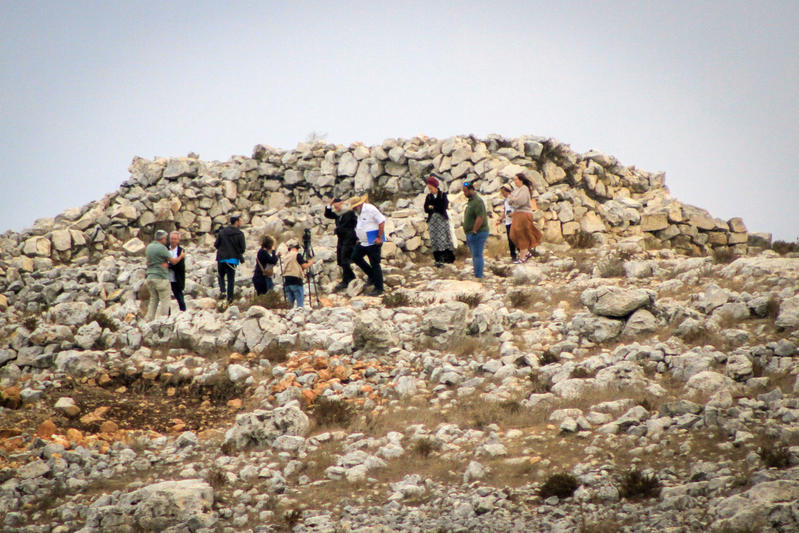Exploring Mount Ebal: How the Mount of Curses becomes a place of blessing

How can a Mountain of Curses possibly be a good thing? Despite the ominous name, Mount Ebal, the Mount of Curses, testifies to a great biblical story. It is still possible to see the remains of what appears to be Joshua’s altar from the time the Israelites entered Canaan.
Certified tour guide, Ran Silberman, shared his expertise with ALL ISRAEL NEWS about what is still visible today at the ancient site, and what it all means.
“We're going to one of the most mysterious and controversial archaeological sites in Israel” Silberman warned, before expounding on its biblical significance.
“Mount Ebal appears five times in the Bible, only five times, and all of them in the very same context,” he explained. The context is a ceremony commanded by God to lay out the blessings that would come for those who followed the Torah and the curses for those who turned away.
Deuteronomy 11:29 gives the instruction: “And when the Lord your God brings you into the land that you are entering to take possession of it, you shall set the blessing on Mount Gerizim and the curse on Mount Ebal.”
What does that mean? These two mountains, Gerizim and Ebal, would be the place from which the blessings and curses from following or abandoning the law would be declared. They would serve as a mountainous visual reminder to keep God’s ways.
Silberman pointed to the full explanation in both Deuteronomy 27 and Joshua 8, along with all the curses proclaimed from Mount Ebal. Essentially half of the 12 tribes were to stand on one mountain to declare blessings, while the other 6 blasted out the curses from Ebal.
Warnings are given not to make a carved or cast metal image, to dishonor parents, to move landmarks or mislead the blind or to pervert justice for the sojourner, the fatherless, and the widow. The people declare that sexual sin, murder, bribery, and ignoring God’s law all incur curses, with an invitation to the people to confirm the covenant: “All the people shall say, ‘Amen.’"
“You can see behind me the altar,” said Silberman showing the ancient structure. “The altar is not more than 10 by 10 meters and it's not very high.” Explaining that initially it was unclear what it all was, Silberman described the excavation process. “In the beginning it was all covered with stones. Nobody could say that this is an altar. In the early '80s a young professor from Haifa University came here through a survey that they did in the mountains of Samaria just after 1967, after the Six Day War, when all this area was released.” The professor, Adam Zertal, realized they had hit upon something interesting and decided to do his PhD on the discoveries.
“So he started excavating for several years,” Silberman continued, “and in the beginning he didn't know what he found. He saw one strange construction – seems like nothing else in Israel or any other places. He knew that it's from the time of the conquest of Joshua, the dating of the ceramics, and also they dated by bones that they found here, but he couldn't say what it is, until he invited some people to share with them.”
“And one guy, a rabbi, an Orthodox Jew, saw this and went home and came back to Adam Zertal and said, you know what this is, what I think? This is exactly according to the plan in the Mishnah of the altar of the temple.”
That was the moment they realized what they might have found.
“Well, if this is an altar and it's on Mount Ebal, what do we read in the Bible about an altar on Mount Ebal?” Asked Silberman. The answer lies at the end of Joshua chapter 8.
“At that time Joshua built an altar to the Lord, the God of Israel, on Mount Ebal, just as Moses the servant of the Lord had commanded the people of Israel, as it is written in the Book of the Law of Moses, 'an altar of uncut stones, upon which no man has wielded an iron tool.' And they offered on it burnt offerings to the Lord and sacrificed peace offerings. And there, in the presence of the people of Israel, he wrote on the stones a copy of the law of Moses, which he had written” (Joshua 8:30-32).
God’s law and the people’s agreement to follow it was what made Israel a nation belonging to God. What a profound blessing.
“And all Israel, sojourner as well as native born, with their elders and officers and their judges, stood on opposite sides of the ark before the Levitical priests who carried the ark of the covenant of the Lord, half of them in front of Mount Gerizim and half of them in front of Mount Ebal, just as Moses the servant of the Lord had commanded at the first, to bless the people of Israel. And afterward he read all the words of the law, the blessing and the curse, according to all that is written in the Book of the Law. There was not a word of all that Moses commanded that Joshua did not read before all the assembly of Israel, and the women, and the little ones, and the sojourners who lived among them" (Joshua 8:33-35).
“Look, you can see there are areas,” said Silberman, pointing out the different parts of the altar. “First of all there is a ramp climbing up. And according to what's written in the Mishnah, and this is even written in Exodus, when you build an altar, you don't use stairs, but you use a ramp. So the priest, when they climb, they will not expose themselves,” he explained.
“And on the left and on the right of this ramp, they found a big amount of burnt bones. All the bones of kosher animals. So what do you think this is?” He asked rhetorically. However, not all the experts agree.
“Most scholars of archaeology will tell you no, this cannot be the altar that Joshua built. And why? Because most modern archaeologists don't believe that Joshua existed. They don't believe…there ever was Joshua,” Silberman lamented, adding that the site is often overlooked for this simple reason.
“You don't find such ancient big constructions from the time of the conquest… sometimes houses but a big altar like this,” said Silberman of the ancient structure. “This is a unique site, there's nothing to compare it to,” he continued. “But this is exactly what's written in the Bible.”
“If you think this is the altar maybe you want to come and visit it,” Silberman offered, adding a caution that visiting requires coordination with the IDF due to its location in Samaria. “But it is possible to view this beautiful and amazing sight,” he assured.
Mount Ebal may have been a place where curses were pronounced as a warning, but the chance to see the stones from a biblical story is a great blessing.

Is All Israel News’ faithful reporting important to you? Be part of it—help us continue by becoming a $5/month supporting partner.

Jo Elizabeth has a great interest in politics and cultural developments, studying Social Policy for her first degree and gaining a Masters in Jewish Philosophy from Haifa University, but she loves to write about the Bible and its primary subject, the God of Israel. As a writer, Jo spends her time between the UK and Jerusalem, Israel.
You might also like to read this:

















